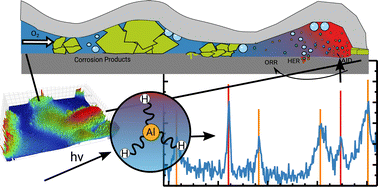Role of aluminium hydrides in localised corrosion of aluminium revealed by operando Raman spectroscopy†
Abstract
Filiform corrosion (FFC) is characteristic of metals such as aluminium and magnesium, usually takes place on coated metals, and spreads from coating defects in the form of filaments with a width on the order of 100 μm. In this work, in situ and operando Raman spectroscopy and optical microscopy were used to characterize the composition and distribution of corrosion products inside growing filaments. The filament head contains water (OH stretching modes, 3000–3600 cm−1), and corrosion products based on aluminium oxide with both tetrahedrally (840 cm−1) and octahedrally (600 cm−1) coordinated Al3+, and with some hydroxyl group content (3075, 1420, 1164 cm−1). Remarkable is the prominent presence of structural motifs as in γ-AlH3 (1045, 1495 cm−1). The tail contains predominantly aluminium oxide with octahedrally coordinated Al3+ and in addition carbonate (1100 cm−1) and aluminium chloride (347 cm−1). Video recordings of the active filigree show hydrogen evolution inside the active head and a very fast precipitation of corrosion products. Re-dissolution, transport and re-formation of the corrosion products is also observed, accompanying start–stop-cycles of the propagation of FFC; this mechanism leads to wavy surface morphologies by lifting of certain coating areas after the passage of the corrosion front as evidenced by 3D optical profilometer analysis. When exposed to the acidic head conditions for a sufficient time, the initiation of other forms of localised corrosion, such as pitting, is possible, which in turn facilitates further propagation of the filament. The in situ detection of hydride which transforms into the typical aluminium corrosion products in due course points to a prominent role of hydride as intermediate in the aqueous corrosion of aluminium.



 Please wait while we load your content...
Please wait while we load your content...